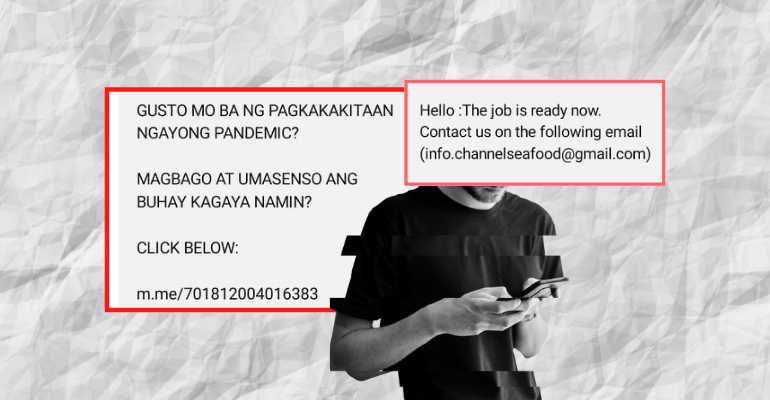If you haven’t applied for a job recently and suddenly received these ‘too good to be true’ text message offers, chances are it is a SCAM.
Many Filipinos have received a lot of sketchy recruitment text starting sometime last late November, promising high-paying salaries.
In fact, this has become a common stint for scammers that it is now called ‘smishing’ (a portmanteau of SMS and phishing). Smishing aims to attack victims by tricking them into providing information or access that benefits the attacker.
Airing their frustrations from this pesky spam text online, most suspect that their phone numbers might have been leaked from contact tracing forms and apps required when entering establishments.
“What did we get from all those contact tracing forms? Random recruitment text messages that are most likely scams (eyeroll emoji),” a netizen tweeted.
Based on the screenshots shared, these messages offer an easy way of earning high salaries for work-at-home or part-time jobs. For example, one message read: “Gusto mo ba ng pagkakakitaan ngayong pandemic? Magbago at umasenso ang buhay kagaya namin? Click below…”
(Do you want to have a source of income this pandemic? To change and have a better life like ours? Click below…)

Senders will then ask their recipients to visit the attached link to avail the work they are offering. Most of them were links to either a WhatApp channel or Facebook Messenger.
Media reporter Jules Guiang shared that he recently received at least ten texts from random numbers, Interaksyon News reported.
“Sobrang disturbing na nakakatanggap ako ng at least 10 messages from random numbers offering job opportunities or mga for sale na products. Pre-pandemic wala namang ganito. Mukhang sa ibang paraan ata nagamit ang contact tracing? Kayo rin ba nakakatanggap?” Guiang said, attaching copies of some of these texts under his tweet.
(It’s so disturbing that I’ve received at least 10 messages from random numbers offering job opportunities or for sale products. We didn’t have this pre-pandemic. It looks like contact tracing was misused. Did you also receive this?)
He received messages that offered a part-time position with P2,000 and above pay.
Sobrang disturbing na nakakatanggap ako ng at least 10 messages from random numbers offering job opportunities or mga for sale na products. Pre-pandemic wala namang ganito. Mukhang sa ibang paraan ata nagamit ang contact tracing? Kayo rin ba nakakatanggap?
— Jules Guiang (@julesguiang) November 15, 2021
Violation of Data Privacy Act
Anyone aware of the Data Privacy Act knows that this alleged leak violates the right of the citizen to have their personal information protected, and many are calling out to the National Telecommunications Commission (NTC) for immediate action.
“I’ve been getting a lot of SMS offering a lot of stuff, #NTC should be looking into this seriously. I assume they got my number from contact tracing forms. Baka binebenta na data natin. #DataPrivacy,” one user said.
In response, Cabinet Secretary and acting presidential spokesperson Karlo Nograles said the National Telecommunications Commission (NTC) is already investigating the matter.
The National Privacy Commission (NPC) also commented that they are already taking swift steps to track the incident. However, the agency has “no sufficient information yet” that would “link the growing concerns on unsolicited SMS to scraping or breach of contact tracing forms/apps.”
“We are also conducting privacy sweeps to check the compliance to DPA requirements,” Roren Chin, chief of NPC’s public information and assistance division, said.
Aside from the violation of the Data Privacy Act of 2021, the act of sending spam or unsolicited text messages is also a violation of the Cybercrime Prevention Act of 2012. Penalties for this act include a fine of up to P10 million and-or imprisonment.
How to block text spam?
Did you receive one of these text messages? If so, remember: RULE #1 is not to CLICK THE LINK, and RULE #2 is not to entertain or reply. These spam or sketchy text messages would remain harmless if you chose to ignore and block these numbers.
While no strategy can 100 percent block it, but you can stop much of it using a SPAM filter. Most messaging apps have this feature which you can enable in the settings.
For Android phones, you can enable spam protection by going to the Message app and clicking the three dots in the upper-right corner > Select Settings > General settings > Spam Protection toggle the Enable spam protection ON. To review the list of numbers you’ve marked as Spam, click the three dots in the upper-right corner and select Spam & blocked.
For iOS users, the Spam blocking of Apple is pretty much more basic as it automatically blocks phone numbers that you don’t have saved in your contact list or haven’t been in contact with before. To active, open the Settings app > scroll down to and select Messages> Unknown & Spam> Toggle on the Filter Unknown Senders. This can, however, cause a problem if, let say, you’re expecting a call from a parcel/food delivery services.
Other messaging apps also have spam filters, which you can find in the Message app’s setting, usually under the Block & Filter option.
Globe subscribers may report mobile numbers responsible for scam or spam messages here. Meanwhile, Smart subscribers can notify via *888 hotline (mobile), 8881111 (landline), or message them at Smart Communications Facebook page and @SMARTCares on Twitter.
But then again, establishments/apps/online platforms/etc. should be more responsible in handling our sensitive information as they promise, yeah?
– WhatALife.ph
You Might Also Want To Read: How to Choose the Right Software Development Provider?



Leave a Reply